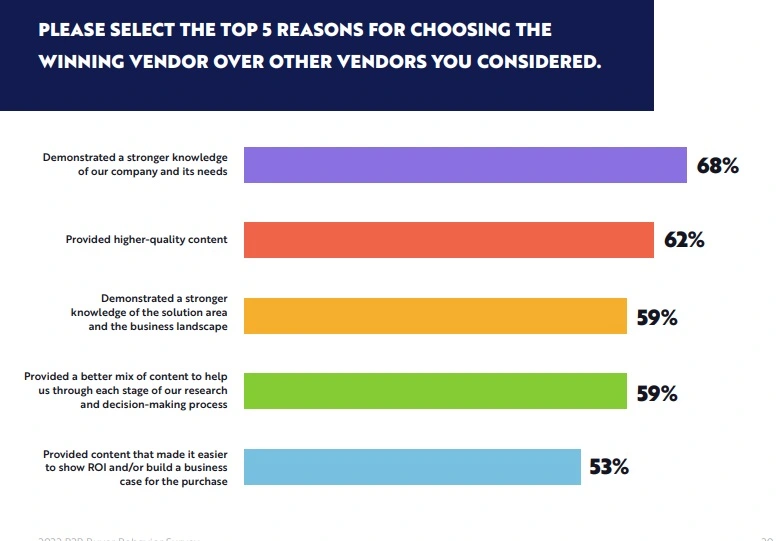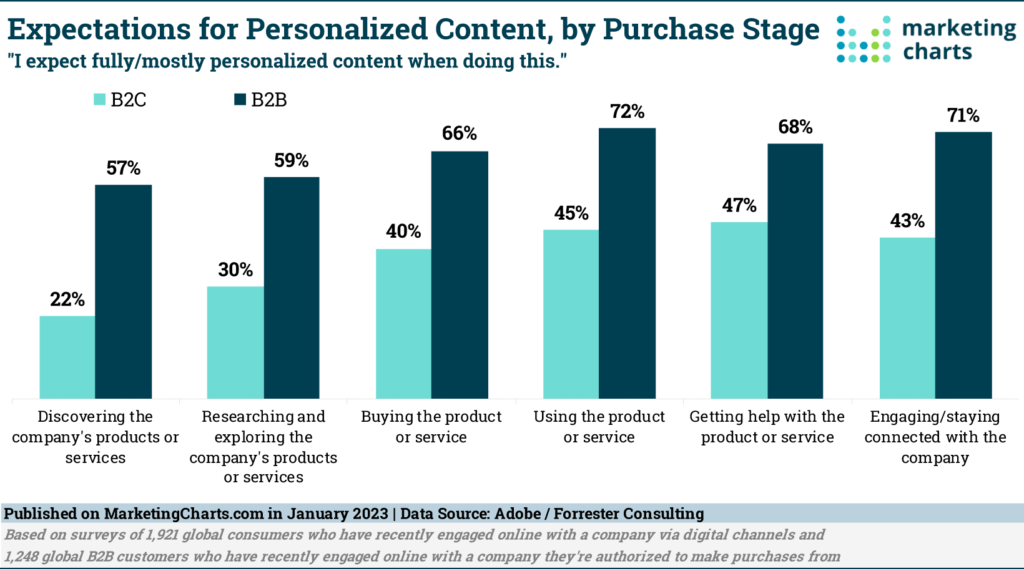The 1-2-3 Guide to Customer-Driven Marketing
Customer-driven marketing is now the B2B standard. In a world where buyers are more empowered to do their own research and informed about available solutions than ever before, they expect companies to shift their focus to tailoring marketing communications to their specific goals and needs.
But how exactly do you implement a customer-driven marketing strategy? Where do you start? How do you align your approaches with the unique preferences that exist across customer groups?
In this guide, we’ll answer these questions and more. When you’ve finished reading, you’ll have a full understanding of why customer-driven marketing is so important, and the key steps to implementing a strategy that works for your B2B business.
Quick Takeaways:
- Customer-driven marketing prioritizes customer needs first, and product/service offerings second.
- B2B buyers choose vendors based on which ones best understand their company-specific needs.
- Defining and segmenting target audiences sets the foundation for customer-driven marketing.
- Other key steps in the process include: Developing customer-focused value propositions, creating high-value content, implementing omnichannel approaches, and personalizing communications.
- Collecting customer feedback is the best way to get insight to inform customer-driven marketing.
What is Customer-Driven Marketing?
As technology has advanced in recent decades, the B2B landscape has experienced a fundamental shift in the way companies and potential customers interact. In the past, it was all up to a business to educate buyers on their offerings, including features, pricing, and steps in the customer journey.
Today, that script has been flipped. B2B buyers are more informed than ever, and they prefer to do most of their research on their own via digital channels. Marketing content is no longer just about promoting products and services. Instead, it must demonstrate an understanding of buyer needs and outline how a company’s offerings can deliver value to customers.
This isn’t just an assumption. Nearly three-quarters of B2B buyers today say that they chose their current vendor over others because they demonstrated a stronger understanding of company-specific needs.

Customer-driven marketing is led by customer needs, pain points, preferences, and experiences. It stays attuned at all times to target customers and continually adjusts to align with their expectations. While marketing strategies of the past put product/service offerings at the forefront, today’s customer-driven strategies prioritize establishing connections first.
At its core, customer-driven marketing embraces three key elements:
- Understanding Your Audience: Gaining insights into your customers’ pain points, goals, and behaviors. This understanding forms the foundation of your marketing strategy.
- Building Relationships: Going beyond the transactional to build lasting relationships with your customers, fostering trust and nurturing loyalty along the way.
- Delivering Value: Consistently delivering exceptional value to your customers, not just through your products or services, but through the end-to-end customer experience you provide.
In the next section, we’ll walk through 9 concrete steps you can take to implement a customer-driven marketing strategy for your B2B organization.
How to Implement Customer-Driven Marketing: 9 Key Steps
1. Identify Your Target Audiences
Start by clearly defining your target audiences. Develop ideal customer profiles (ICPs) that identify key organizational traits your business buyers typically have, and use buyer personas to describe individual decision makers within those organizations.
2. Segment Your Audiences
Customer segmentation is the practice of categorizing customers into groups with shared characteristics or behaviors. Doing so allows you to create targeted marketing campaigns and strategies that align with the unique needs and preferences of each group.
Use your ICPs and buyer personas to segment customer groups objectively, then develop strategies to resonate with each one. Specifically, consider which parts of your product/service portfolio are relevant to each group, and the needs or goals driving them to seek your solutions.
3. Develop Customer-Focused Value Propositions
Next, develop customer-focused value propositions—compelling statements that communicate the value and benefits a product or service offers to its customers. Remember: These should focus on customers first, and features second. Tools like Strategyzer’s Value Proposition Canvas can guide you in this process, helping you align your offerings with the customer needs they fulfill.
4. Publish High-Value Content
As B2B buyers perform their due diligence on potential providers, your content is what delivers the first impression they have of your business. Just like your direct marketing messages and communications, your content must be customer-driven. It should provide value by helping customers solve problems and accomplish important tasks or goals.
Some of the best types of content for doing this include:
- Educational blog articles
- How-to videos
- Ebooks and whitepapers
- Downloadable PDF guides
- Customizable templates
Creating a diverse content library that includes many types of content is the best way to engage your various customer groups.
5. Create an Omnichannel Engagement Strategy
Customer-driven marketing used to be all about taking a multichannel approach. Today, however, B2B buyers expect businesses to take things a step further. They want their experiences to be omnichannel, or fully connected across channels and platforms.
For example: If a buyer indicates specific interests via a website survey, they want those preferences to be remembered and honored across other channels, such as email or social media.
While multichannel marketing engages customers on many channels, omnichannel marketing ensures those channels are connected to create a holistic and consistent experience.

6. Personalize Communications
Personalization is no longer a nice-to-have in customer-driven marketing: It’s table-stakes. B2B research consistently shows that buyers want personalized communication, and even become frustrated when they don’t receive it. Further, they want personalization to extend to the content that’s delivered to them at every stage of their journey—even during initial discovery.

To personalize your marketing communications, be diligent about collecting customer data and using tools like your CRM or email marketing platform to leverage it for personalizing outreach efforts. Effective ways to personalize marketing messages include:
- Using individual contact names or company names
- Sharing dynamic content that’s aligned with customer interests
- Mentioning past interactions in new communications
- Customizing product/service offerings to meet specific needs
7. Collect and Use Customer Feedback
Collecting customer feedback is the most direct and effective way to gain insight that can inform your customer-driven marketing strategy. Incorporate customer feedback strategies such as surveys and focus groups to learn about your unique customers and tailor your strategies accordingly.
The Big Takeaway
Customer-driven marketing is all about putting customers first, and product/service offerings second. It may feel counterintuitive at first, but by prioritizing customer needs and value delivery, you engage your buyers more authentically and build relationships that stand the test of time.
Plus, the customers you attract will be better fit for your business and solutions, meaning their long-term success and satisfaction will be higher.
Televerde can help you develop and implement a customer-driven marketing strategy built on the right tools, technologies, and best practices needed to succeed. Contact our team to learn more.


